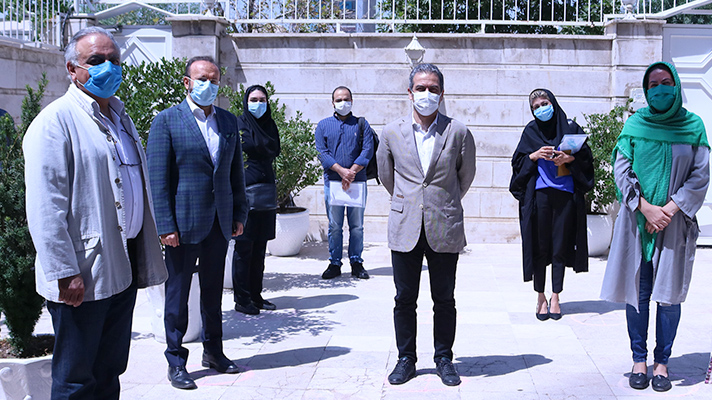
COVID-19: The Domino Effect on Consumer Behavior Change 
The annual press conference of the dnaunion group was held. Present at the meeting were Naser Pashapour Niko, CEO of dnaunion group; Mohammad Mousavi, board member of the group and CEO of Etteghat Tasvir Agency; and Saeed Nabavian, senior qualitative research consultant at EMRC (Market and Media Research Company).
The session began with the presentation of a research report prepared by EMRC. Pashapour Niko stated: “This research report examines and analyzes changes in consumer behavior during the COVID-19 period compared to before it. Since 2001 (year 80 in the Iranian calendar), EMRC has regularly monitored consumer behavior and attitudes. Such reports are highly important for analyzing social behaviors of audiences and consumption patterns. The report shows that changes in consumer behavior have had a domino effect on businesses, causing them to change as well. The report was prepared with the participation of 1,000 residents from six major Iranian cities: Tehran, Isfahan, Shiraz, Tabriz, Mashhad, and Ahvaz. The report covers concerns, crisis impact, people’s attention to safety measures, and more. Staying at home and unemployment are among the first impacts that COVID-19 had on Iranian households. Income reduction and payment delays are the third impact that respondents mentioned regarding COVID-19’s effects on people’s lives.”
As mentioned, staying at home was one of the earliest impacts of COVID-19 on people’s lives. Activities such as spending time with family members, watching television, engaging in social networks, reading books and magazines, and so on, were among the activities people engaged in during this period.
The research also inquired about people’s concerns. Participants identified contracting COVID-19 for themselves and their families as the greatest concern. Income reduction and lack of access to hygienic products for protection were other worries mentioned. People somewhat alleviated these concerns through regular hand washing, disinfecting packaged goods, reducing outings, boosting immune systems, and so forth. Such behavioral changes also affected purchasing behavior. During COVID-19, the volume of snack and cigarette purchases decreased. Research showed that COVID-19 did not cause anyone to start smoking, but for various reasons, smokers increased their consumption. On the other hand, 34 percent growth was observed in purchases of personal and household hygiene products. The volume of food and beverage purchases did not show significant changes.
Another question answered by consumers in the study concerned changes in purchasing methods during COVID-19. Data showed that on average, 12 percent of supermarket purchases during the pandemic were made non-presentially (9 percent online and 3 percent by phone). About 20 percent of respondents made such purchases. Half of this 20 percent stated that the crisis caused an increase or change in their purchasing behavior. Half of them cited protection from the coronavirus as the reason. However, if the virus disappears, they will revert to in-person shopping.
The other half of online shoppers cited the advantages of online shopping—such as time-saving, broader selection, and convenience—as reasons for their choice, and indicated they will continue online shopping even after the pandemic.
Pashapour further added: “The advertising market and claims made by companies and brands during COVID-19 became very heated. Brands claimed to have taken actions to keep consumers safe. Such methods were used to attract audiences and gain market share. However, research data shows these efforts have not been effective, as at most 2 out of 10 people heard these brand claims across all product groups. Also, brand switching or willingness to switch influenced by these claims varied across product groups, with at most 3 percent of consumers reacting to such claims.”
Overall, consumers expect more from brands than just claims. Four out of every 10 respondents expect brands active in the market to maintain or reduce prices. Additionally, compliance with health protocols and product quality improvement are among other expectations of consumers.
Following this, the group’s managers answered questions from journalists representing various media outlets.
In response to a question about why, despite COVID-19 keeping people home, online shopping inclination has not significantly increased, Pashapour said: “Online shopping and use of online technologies have jumped during COVID-19. Although this jump is still small, it is significant and should not be overlooked. Research shows COVID-19 has accelerated the growth trajectory of online businesses. If brands like Alibaba have declined, it is due to the tourism industry’s downturn. Other online businesses have grown. The acceleration we talk about usually takes three to five years, but COVID-19 has shortened this timeline.”
Mohammad Mousavi was asked if COVID-19 increased TV advertising and whether a comparison can be made between TV and outdoor advertising during the pandemic. He said: “After examining consumer behavior changes, we find that TV viewing increased during COVID-19. Consequently, TV advertising exposure also increased due to a larger audience. On the other hand, with reduced intra-city travel and fewer cars on the roads, it is assumed audiences were less exposed to outdoor advertising. However, when life returned to normal, brands took outdoor advertising more seriously and used it to convey their messages. Outdoor advertising can also be used for local campaigns aimed at specific regions. For these reasons, outdoor advertising saw increased acceptance during COVID-19. Furthermore, brands with moderate budgets can use outdoor advertising, which may not be feasible for TV advertising due to cost. Brands utilizing TV advertising also employed outdoor ads to complement their campaigns. This revitalized outdoor advertising after a decline in March.”
Accordingly, social media usage also increased. However, due to reasons like limited access to all digital advertising tools, brands still lean more toward outdoor and TV media. This situation has prevented definitive conclusions about the superior effectiveness of digital advertising. Digital advertising still has growth potential. Currently, only about 4 to 6 percent of advertising expenditure in Iran goes to digital advertising, which is growing at 5 to 7 percent compared to four years ago.
Mousavi discussed COVID-19’s social impacts: “Some impacts of COVID-19 are immediate, while others occur long-term, and reactions vary accordingly. For example, at the virus outbreak, public demand for disinfectants soared, and the number of brands producing these materials sharply increased. Over the long term, people began focusing on mask use and improving workplace safety. Thus, reactions to COVID-19 vary in timing. Immediate effects primarily impact end consumers and producers, while long-term effects mainly influence B2B sectors.”
Nabavian was asked if consumption increased during COVID-19. He answered: “Some changes in Iran differ from other countries because Iran is currently experiencing a severe economic crisis. Our country suffers from unusual inflation, especially in the essential goods basket of households. These events, along with the psychological crisis, have reduced consumer purchases not only in Iran but in other countries as well. Also, the number of items in household baskets has decreased. Consumer perception has changed, and some essential goods have become non-essential.”
Therefore, COVID-19 has created similarities between Iran and other countries. Additionally, people’s use of educational apps, home exercise, and so on has increased. Attention to the environment and health-related apps has also grown. The COVID-19 crisis accelerated certain developments, fostering personal growth that partly reduces depression, as people pay more attention to themselves and their families than before. Overall, COVID-19 has fostered solidarity because people understand how much their decisions affect others’ lives.
Many crises can become opportunities to institutionalize cultural or behavioral changes. COVID-19 led many individuals to purchase new products from online stores. Moreover, COVID-19 could normalize bicycle use in our country, and municipalities can promote this culture. In this context, use of public transportation has decreased by up to 35 percent in major countries.
Pashapour was asked whether the trend of large companies toward online sales will yield positive results. He said: “Large companies should pursue online sales with the goal of retail, as wholesale will not be effective for them. Consumers prefer to purchase their products through a single gateway, hence their inclination toward online shopping. Therefore, wholesale online sales do not align with consumer behavior. Businesses must carefully analyze audience purchasing patterns in this context.”
Regarding whether the crisis has caused liquidity shifts among businesses, Pashapour said: “Since our country faced an economic crisis before COVID-19, it cannot be conclusively stated that recent economic events are entirely due to COVID-19. Our situation differs from other countries. Iran has generally not been part of the global trade table disrupted by COVID-19. The conditions created have certainly caused liquidity shifts among businesses. COVID-19’s pressure has made other countries act more flexibly toward Iran. Consequently, the pandemic’s impact on Iran is less than on other countries. COVID-19 has also made other countries more flexible toward Iran and less compliant with unilateral U.S. policies.”
At the end of the session, Pashapour Niko stated: “Brand-owning companies and agencies need tools to organize and value purchases from different gateways. Currently, each gateway sets its own pricing, with no supervision. Also, digital advertising requires sending ads to nearly 300 places. dnaunion group has invested in digital organization and introduced the Hapirad tool to the market. Currently, most digital investments are spent on Instagram and influencers, which is not correct; we should also use other tools.”
In summary, the economic crisis and COVID-19 have caused changes in audience behavior and attitudes. These changes will trigger further shifts and reshuffling in household shopping baskets. If businesses monitor these changes carefully, analyze them, and adjust strategies accordingly, they can turn threats into opportunities. If businesses do not act agilely toward changes, they will miss the chance to benefit from the current situation.





